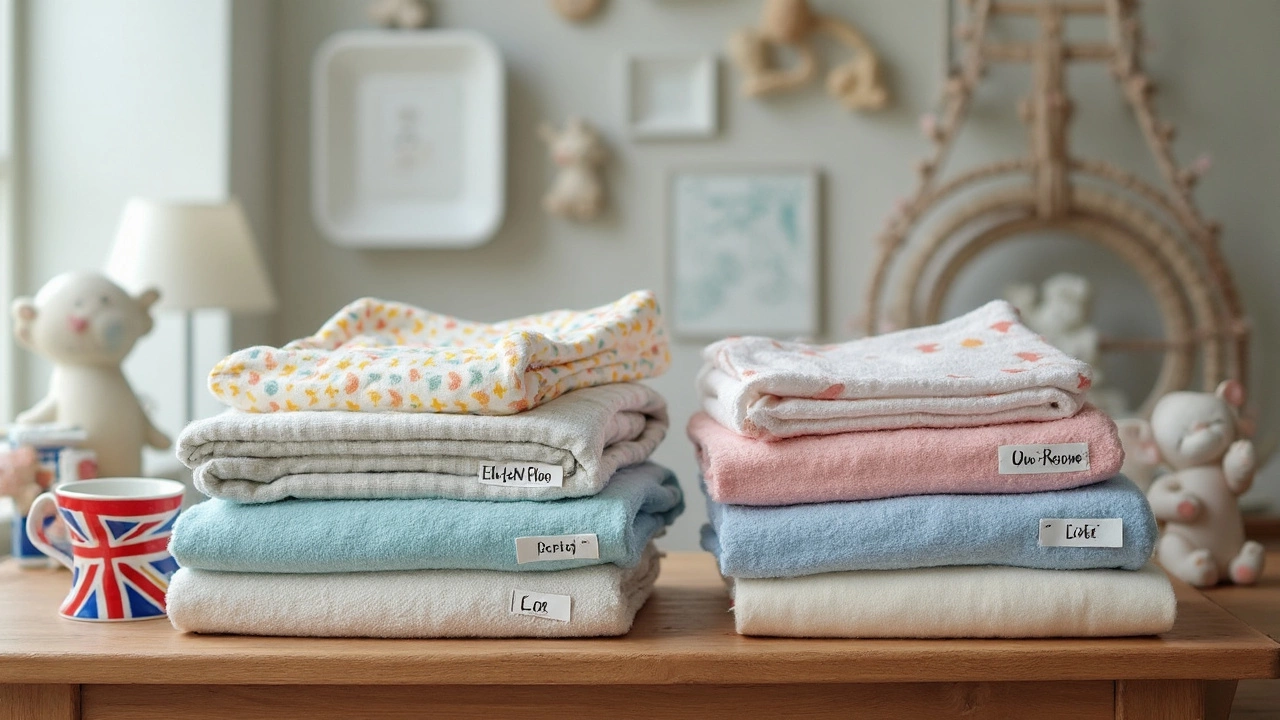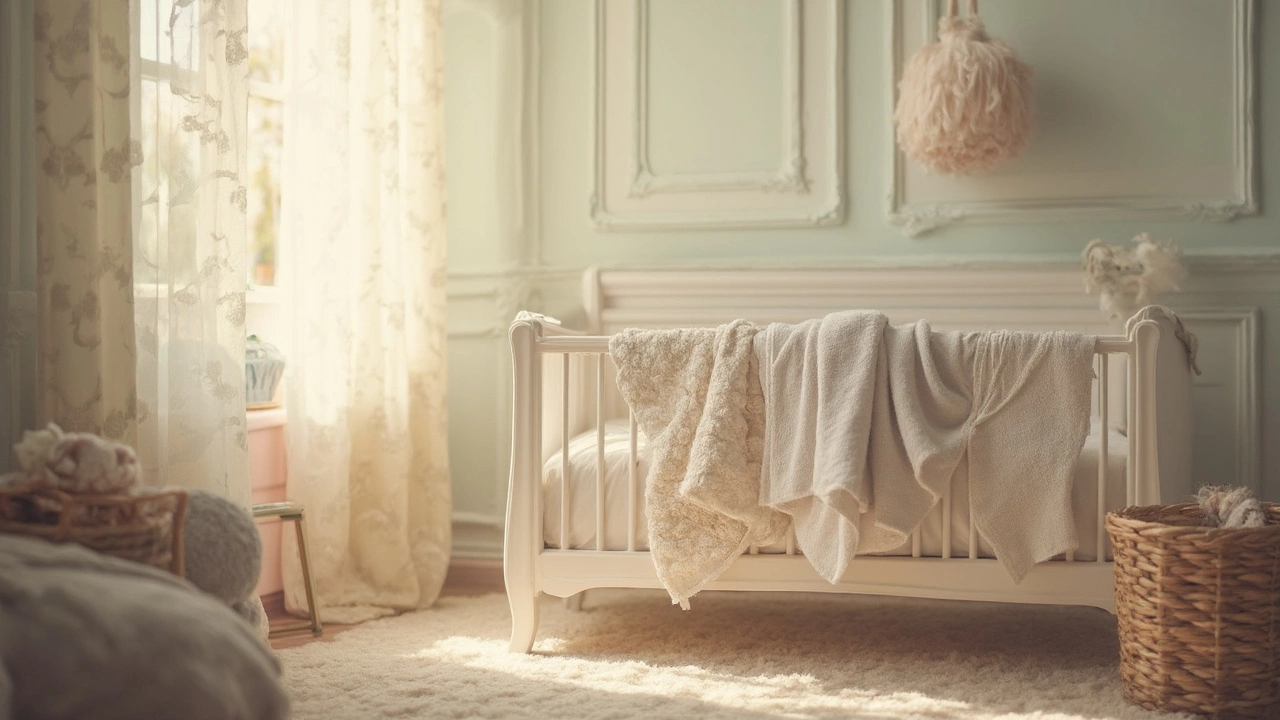When it comes to snuggling up your baby, it's not just about the cuteness factor—safety is key. So, what kinds of blankets are actually best for newborns? Turns out, there's a bit more to it than just having the fluffiest or cutest fabric.
First off, you want to look for blankets that are specially designed for babies. These are often lightweight and breathable, reducing the risk of overheating or suffocation. A good rule of thumb is to choose blankets that you can see some light through when you hold them up. This ensures they have enough breathability.
Materials matter too. 100% cotton is a great go-to because it's soft, breathable, and usually gentle on sensitive skin. But there are other options like muslin that are also worth considering. Remember, allergies can be a thing even for babies, so know what fabrics your baby reacts well to.
Before you get all tied up in types and materials, don't forget about seasonal changes. A lightweight cotton blanket might be perfect for summer, while cooler months might call for a warmer fleece. The goal here is to keep your baby warm but not too hot. You wouldn’t want to be sweltering under layers in the middle of July, right?
Types of Blankets
Alright, first things first—let's break down the different kinds of newborn blankets you'll come across. Each type has its unique purpose, so knowing these will help you decide what's right for your tiny bundle.
Receiving Blankets
The name might sound fancy, but they're basically the Swiss Army knife of blankets for babies. These are lightweight and versatile, perfect for swaddling, and can even double as burp cloths or a quick changing mat in a pinch. Keep a few of these handy because they’re going to be your everyday go-to for minor messes and wraps.
Swaddle Blankets
These blankets are specifically designed for wrapping up your baby like a comforting burrito. They help your little one feel secure, mimicking the cozy feeling they had in the womb. You’ll find both regular and Velcro versions, which are super useful for those middle-of-the-night changes when you’re half-asleep.
Sleep Sacks
Think of sleep sacks as wearable blankets. They’re a safer option compared to traditional blankets when it comes to infant sleep. Sleep sacks can help prevent Sudden Infant Death Syndrome (SIDS) by eliminating loose bedding in the crib. Plus, they’re great for wiggly babies who constantly kick off regular blankets.
Receiving vs Swaddle vs Sleep Sack: Quick Comparison
| Feature | Receiving Blanket | Swaddle Blanket | Sleep Sack |
|---|---|---|---|
| Usage | Versatile: swaddling, burp cloth | Primarily for swaddling | Safe sleep, replaces loose blankets |
| Safety | Safe with proper use | Safe when wrapped properly | Considered safest for sleep |
| Convenience | Highly convenient | Moderately convenient | Simple dressing |
Security and Comfort
Security is a big deal when it comes to baby bedding. Blankets shouldn't be too loose or too tight, and they must allow your baby to move comfortably. Also, remember that babies grow fast, so having a mix of blanket sizes in your collection isn’t a bad idea. This prepares you for those growth spurts without having to rush to the store each time.
Safe Materials
When picking blankets for your newborn, safe materials are non-negotiable. The last thing you want is for your baby's sensitive skin to react to a rough or itchy fabric. Trust me, going for a soft touch is always a good idea, but it's more about what's in the fabric. Here’s what you need to know.
All About Cotton
Cotton often tops the list of ideal materials for newborn blankets. It's breathable, which helps regulate your baby's body temperature—you know, because they can't exactly say when they're too hot or cold! Plus, it's hypoallergenic, naturally fighting off irritations. Organic cotton is even better, as it skips all the chemical treatments, pesticides, and dyes.
Why Muslin is a Keeper
Another star player in the blanket game is muslin. It's great for newborns because it's super lightweight and naturally breathable, making it perfect for swaddles. Muslin gets softer with every wash, so it only improves over time. This means you’re not just investing in comfort for now, but for the long run too.
Fleece and Microfiber Cautions
Now, let's talk fleece and microfiber. These are undoubtedly soft and warm, but they’re synthetic. This can make them less breathable than natural options. They might be okay for a cold snap, but be careful not to overuse them. Always check regurgitation or spills don't easily get trapped, causing hygiene issues.
Quick Glance at Fabric Pros and Cons
| Fabric Type | Pros | Cons |
|---|---|---|
| Cotton | Breathable, hypoallergenic | Wrinkles easily |
| Muslin | Lightweight, gets softer | Not as warm for winter |
| Fleece | Warm, plushy | Less breathable, synthetic |
Bottom line: If you're overwhelmed by the choices, stick with cotton or muslin for everyday use. Save the fleece for colder nights but keep an eagle eye out for overheating.

Seasonal Considerations
Mother Nature sure likes to keep us on our toes, and so does preparing your newborn for different seasons! Whether you're dealing with the sweltering heat of summer or the biting cold of winter, making sure your baby is comfortable is key.
Summertime Snuggles
During warm months, the priority is keeping your baby cool and comfy. You might think a blanket isn't necessary, but a lightweight option like cotton or muslin can help. These materials are breathable and absorb moisture, which is perfect for those hot, sticky nights. If you plan on being in air conditioning, consider adding a light swaddle or sleep sack for extra coziness without overheating.
Winter Warmth
In colder months, keeping your little one snug is the name of the game. Fleece blankets can be a lifesaver, providing warmth without the weight. Remember, though, it's still important not to over-layer. The general rule is one more layer than you would wear comfortably. A footed sleeper combined with a warm sleep sack usually does the trick.
Spring and Fall: Transitional Times
The in-between seasons can be the trickiest. The goal is to stay adaptable. Layering becomes your best friend. Start with a basic cotton layer and add on as necessary. It’s always easier to add more layers if your baby feels chilly than to take them off if they’re too hot.
Whatever the weather, keeping your baby bedding simple is a win. Overdoing it with stuffed animals and puffy quilts can increase suffocation risks. A safe sleep space can never be underestimated.
Safety Tips
When it comes to your newborn's nap time, safety is at the top of the list. Here are some essential tips to ensure your baby sleeps soundly and safely.
Understanding Safe Sleep Practices
The first rule of thumb: always place your baby on their back to sleep. It significantly reduces the risk of sudden infant death syndrome (SIDS). Keep the crib free of loose blankets, pillows, and other soft items that could pose a suffocation risk.
Using the Right Blanket
- Choose a newborn blanket that fits the crib snugly; oversized blankets can cover your baby’s face during the night.
- Always tuck the blanket in tightly across the foot and sides of the crib, leaving only enough room for your baby's toes to wiggle.
- Consider a sleep sack as an alternative to traditional blankets. It provides warmth and comfort without any risk of covering the face.
Check the Materials
Ensure that the blanket is made from breathable materials like cotton or muslin. Fleece might be perfect for a cozy winter but could lead to overheating in warmer seasons.
Temperature is Key
A good rule to follow is to dress your baby in one more layer than what you'd be comfortable in. Watch for signs of overheating, like sweating or flushed skin, to keep your baby comfortable and safe.
| Room Temperature | Recommended Clothing |
|---|---|
| Under 65°F | Onesie, swaddle, and fleece sleeper |
| 65°F - 70°F | Onesie, cotton sleeper, and swaddle |
| 70°F - 75°F | Onesie and sleep sack |
Regular Checks
Peek in on your sleeping baby every now and then. This not only helps to spot any potential issues early but also gives you peace of mind knowing your little one is sleeping with care.
By following these safety tips, you’re making sure your baby’s sleep environment is as secure as it can be. Just a little effort can go a long way in keeping your baby safe and sound through the night.
